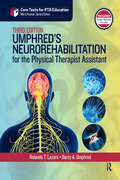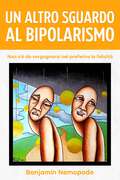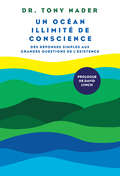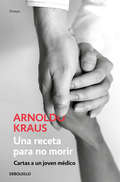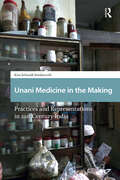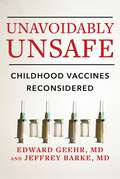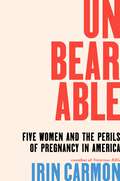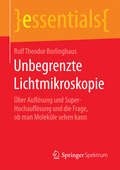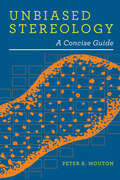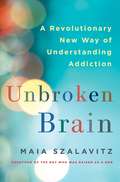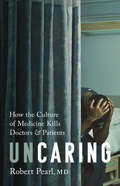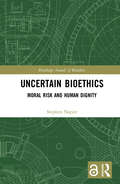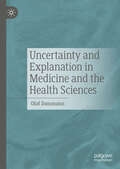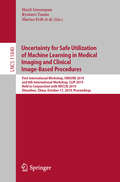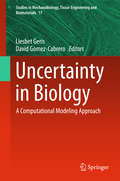- Table View
- List View
Umphred's Neurorehabilitation for the Physical Therapist Assistant (Core Texts for PTA Education)
by Darcy Umphred Rolando LazaroA comprehensive guide to neurological rehabilitation for physical therapist assistants (PTAs), Umphred’s Neurorehabilitation for the Physical Therapist Assistant, Third Edition presents contemporary, evidence-based principles and techniques for examination and intervention for individuals with neurological conditions.Umphred’s Neurorehabilitation for the Physical Therapist Assistant, Third Edition addresses a wide variety of pediatric and adult neurological disorders, including spinal cord injury, brain injury, stroke, Parkinson’s disease, multiple sclerosis, amyotrophic lateral sclerosis, Guillain-Barré syndrome, and more.Drs. Lazaro and Umphred have updated this classic text to reflect current and emerging trends in physical therapy, including: The role of the PTA in neurocritical care The role of the PTA in management of clients with lifelong impairments and activity limitations Technology in neurorehabilitation Also included is a new chapter on functional neuroanatomy, which provides the foundational background for understanding the relationship between the structure and function of the nervous system.The Third Edition also features helpful instructor and student resources. Included with the text are online supplemental materials for faculty use in the classroom.Umphred’s Neurorehabilitation for the Physical Therapist Assistant, Third Edition is the definitive resource for any PTA faculty, student, or clinician interested in the physical therapy management of individuals with neurological conditions.
Un altro sguardo al bipolarismo: Non c’è da vergognarsi nel preferire la felicità
by Benjamin NemopodeL’incredibile percorso di un uomo con il disturbo bipolare Come è sprofondato nella più profonda disperazione, per poi uscirne trionfante. Ti è stato diagnosticato il bipolarismo? Conosci qualcuno che soffre di questa malattia e che lotta per ritrovare se stesso? Vorresti saperne di più di questo terribile disturbo psicologico? Sei alla ricerca della pace o sei interessato al buddhismo? Disturbo bipolare o verità del risveglio spirituale? Segui il viaggio di Arthuro Jobsquare, bipolare, da Parigi a Montreal, passando per Londra, fino allo stato di buddha. Un’avventura fantastica, uno scacco al bipolarismo. Un’incredibile determinazione nel voler superare la malattia che minacciava di controllarlo per sempre. Descrizione della malattia e dell’incredibile percorso di un bipolare di tipo I. Questo libro espone l’incredibile percorso di una persona bipolare fornendo una descrizione corretta e accurata della malattia. Se cerchi un libro sul disturbo bipolare o sul risveglio spirituale, non cercare oltre, l’hai trovato... Ordina SUBITO la tua copia e inizia il tuo percorso di risveglio. Estratti dalle recensioni di lettori Amazon ★★★★★ “L’autore condivide con noi il suo doloroso percorso di vita con il disturbo bipolare di tipo I. Una testimonianza toccante, compiuta e scritta splendidamente...” - Frédérique Madison (Francia) ★★★★★ “Ho letto questo libro in più tempi, cosa che non è mia abitudine fare. Ma ogni tanto ho dovuto fermarmi a riprendere fiato. Si sente chiaramente tutta la sofferenza di una persona che cerca di prendere le distanze dalla propria esperienza...” - Armand Poursin (Francia) ★★★★★ “Consiglio questo libro in quanto utile complemento alle proprie ricerche sulla malattia e anche come testimonianza di chi ne è affetto. Ora posso dire di averla compresa molto più chiaramente e di amare
Un mundo extraño: Apuntes de una neuróloga sobre la mente humana
by Isabel GüellUnlibro que nos invita a maravillarnos ante la complejidad de la mente humana.A través de casos clínicos y con la pandemia como telón de fondo, este libro explora el extraño mundo de las enfermedadesneurológicas y juega con nuestra forma de experimentar el día a día para guiarnos por los maravillosos caminos de la mente.Gracias a su dilatada experiencia como neuróloga y su enorme capacidad divulgadora, la doctora Isabel Güell se asoma al ámbito del recuerdoy la memoria, de las emociones, de los sentidos, del libre albedrio, del lenguaje o de la personalidad. Cuestiones complejasy enigmáticas que no solo demuestran la curiosidad, laerudicióny la empatía de la autora, sino que, en su conjunto, se convierten en una espléndida indagación de la naturaleza humana.El resultado es un libro vibrante y luminoso, escrito desde la pasión por los demás y con un gran talento literario que encaja en latradición de autorescomo Oliver Sacks, donde la ciencia y la literatura caminan de la mano para convertirse en fuente de conocimiento y reflexión.
Un océan illimité de conscience
by Dr. Tony NaderDes réponses simples aux grandes questions de l'existence. Prologue de David Lynch. «Dans ce livre qui fera date, les idées que développe le Dr Nader ont le pouvoir de changer le monde. Il apporte des réponses fondamentales aux questions qui ont fasciné et intrigué depuis longtemps philosophes et scientifiques. Qu'est-ce que la conscience, sommes-nous libres ? Comment réussir au mieux sa vie, réaliser ses désirs, susciter la paix et l'harmonie entre les êtres humains et les pays ? À toutes ces questions, il apporte des solutions fondées sur un paradigme fondamental et simple qui unifie l'esprit, le corps et l'environnement en un océan unique d'Être pur, de conscience pure. Un livre que toute personne à la recherche de la vérité ultime et absolue se doit de lire.»David Lynch «Je veux que toute le monde sache ce qu'est la conscience et comment la développer pour profiter du plein potentiel de la vie individuelle et sociale.»Dr. Tony Nader
Un'intervista con Jeffery Khoury
by Richard G Lowe Jr Vita CumboQuesto libro riporta l'affascinante intervista dell'autore a Jeffery Khoury un giovanissimo imprenditore che ci presenta la sua applicazione innovativa che permette l'applicazione medicina telematica nella vita di tutti i giorni, pensata per chiunque. Parliamo di una vera e propria avanguardia sul mondo delle applicazioni per i nostri cellulARI e, insieme, sul modo nuovo di connettersi con il proprio dottore. Questo giovane ragazzo ci spiega come sia semplice per tutti usare questo nuovo strumento, come è nata questa brillante idea e gli sforzi per realizzarla, dandoci anche una preziosa lezione di vita.
Una receta para no morir: Cartas a un joven médico
by Arnoldo Kraus«Arnoldo Kraus ha hecho de su vida una pasión por la muerte, o más bien una pasión por la vida y por el bien morir.» Eduardo Matos Moctezuma En esta obra, Arnoldo Kraus ofrece una visión integral y sucinta sobre saberes, coyunturas y deudas que ha debido adquirir, enfrentar y resolver a lo largo de sus años en el ejercicio de la medicina. El sustento de estas reflexiones es la experiencia práctica, pero no sólo ella; también varias lecturas, una posición de compromiso ético y la certeza de no saberlo todo. Tanto los aspirantes a médico como los lectores en general encontrarán aquí motivos para confiar en que no se ha roto definitivamente el vínculo entre humanismo y medicina.
Unaffordable: American Healthcare from Johnson to Trump
by Jonathan EngelWritten for nonexperts, this is a brisk, engaging history of American healthcare from the advent of Medicare and Medicaid in the 1960s to the impact of the Affordable Care Act in the 2010s. Step by step, Jonathan Engel shows how we arrived at our present convoluted situation, where generic drugs prices can jump 1,000 percent in a day and primary care physicians can lose 20 percent of their income at the stroke of a Congressional pen. Unaffordable covers, in a conversational style punctuated by apt examples, topics ranging from health insurance, pharmaceutical pricing, and physician training to health maintenance organizations and hospital networks. Along the way, Engel introduces approaches that other nations have taken in organizing and paying for healthcare and offers insights on ethical quandaries around end-of-life decisions, neonatal care, life-sustaining treatments, and the limits of our ability to define death. While describing the political origins of many of the federal and state laws that govern our healthcare system today, he never loses sight of the impact that healthcare delivery has on our wallets and on the balance sheets of hospitals, doctors' offices, government agencies, and private companies.
Unani Medicine in the Making: Practices and Representations in 21st-century India (Health, Medicine, and Science in Asia)
by Kira Schmidt-StiedenrothUnani Medicine in the Making examines the institutions and practices of Unani medicine, the Graeco-Islamic healing practice based on the humoral theory attributed to Hippocrates and officially recognized as a system of medicine in India. Drawing on diverse materials, including Urdu sources, interviews with practitioners, and observations in clinics, the book explores what Unani medicine is today by attending to its multiplicity, scrutinizing apparent tensions between the understanding of Unani as a system of medicine and its multiple enactments as Islamic medicine, medical science, or alternative medicine. Ethnographic details provide vivid descriptions of the current practice of Unani in India, and invite readers to rethink the idea that humoral medicine is incommensurable with modern medicine and science, and that the modernization of Asian medicines invariably leads to their biomedicalization. Ultimately, the book also discusses the relationship of Unani with Muslim communities, examining the growing practice of Prophetic Medicine in Urban India and increasing representations of Unani as Islamic Medicine.
Unavoidably Unsafe: Childhood Vaccines Reconsidered
by Edward Geehr Jeffrey BarkeAn in-depth guide for parents as they struggle to make informed decisions about vaccines for their children. In Unavoidably Unsafe, Dr. Edward Geehr and Dr. Jeffrey Barke confront the prevailing beliefs surrounding childhood vaccines with unflinching scrutiny and bold insight. As seasoned physicians, they acknowledge the revered status vaccines hold in modern medicine while bravely questioning their safety and efficacy. From the historical triumphs of polio eradication to the complexities of modern immunization schedules, Geehr and Barke unravel the layers of vaccine development and regulation. They shed light on the unintended consequences of vaccine mandates and the erosion of informed consent in the face of mounting pharmaceutical influence. Drawing on decades of clinical experience and exhaustive research, the authors challenge conventional wisdom by addressing critical issues such as: The proliferation of childhood vaccines and their impact on public health The National Childhood Vaccine Injury Act and its implications for vaccine safety The symbiotic relationship between pharmaceutical companies and regulatory agencies The shortcomings of Emergency Use Authorization and its implications for vaccine safety The presence of potentially harmful additives in vaccine formulations A fresh look at possible links between vaccines and autism Cautionary considerations regarding mRNA vaccines and their suitability for children Practical guidance for evaluating the risks and benefits of vaccines for individual children The significance of proper informed consent and patient advocacy in vaccination decisions Unavoidably Unsafe is not an indictment of vaccines but a call to arms for informed decision-making and transparency in healthcare. Geehr and Barke aim to empower parents, guardians, and healthcare providers with the knowledge needed to navigate the complex landscape of childhood immunization responsibly. In a rapidly evolving medical landscape where uncertainties abound, Unavoidably Unsafe serves as a beacon of clarity and integrity, reaffirming the importance of critical thinking and patient-centered care in safeguarding the health and well-being of future generations.
Unbearable: Five Women and the Perils of Pregnancy in America
by Irin CarmonFrom the award-winning New York magazine reporter and coauthor of the New York Times bestseller Notorious RBG, an ambitious and passionate exploration of what&’s gone wrong with pregnancy in America, through the lens of history, politics, and the searing experiences of five women. Journalist Irin Carmon was eight months pregnant when the Supreme Court allowed states to ban abortion, unleashing pain and suffering for those who didn&’t want to be pregnant and, shockingly to some, those who did. What was clear to Carmon from her dozen years of reporting—and from what she felt in her bones—was how incomplete the American story of reproduction had been, and how much had been unexpressed, hidden, or taken for granted, and not just by conservative justices or in red states. Whether in cosmopolitan, liberal New York City or rural Alabama, the entire system is broken. Unbearable tells a deeper story, going beyond the headlines and any one experience or choice, and grounded in history and journalism. It introduces us to five women navigating pregnancy care—from that first positive pregnancy test through joy, loss, and the unforeseen—in a country that is at best indifferent and at worst willfully cruel, and to brave, outnumbered people fighting to make it better. Written with deep empathy and analytical rigor, Unbearable is at once a moving story of interconnection, a harrowing exposé, and assertion of humanity. Above all, it is a powerful call for solidarity, regardless of our circumstances or our decisions.
Unbegrenzte Lichtmikroskopie: Über Auflösung und Super-Hochauflösung und die Frage, ob man Moleküle sehen kann (essentials)
by Rolf Theodor BorlinghausRolf T. Borlinghaus erläutert die Ursachen für die klassische Begrenzung der Lichtmikroskopie und beleuchtet die neuen Super-Hochauflösungstechniken. Dies ist besonders aktuell, da der Nobelpreis 2014 für Chemie für die Entwicklung von Technologien vergeben wurde, die es nun ermöglichen, mit Lichtmikroskopen feinere Details aufzulösen, als es die klassische Theorie einschränkend vorhersagt. Diese neuen Methoden stellen aber nicht das bisherige Weltbild der Optik in Frage, vielmehr nutzen sie ganz andere Phänomene, um mittels klassischer Optik Positionsbestimmungen von Molekülen durchzuführen. Das ist theoretisch beliebig genau möglich.
Unbemannte Flugsysteme in der medizinischen Versorgung: Strategien zur Überwindung von Innovationsbarrieren
by Steffen Fleßa Klaus Hahnenkamp Mina BaumgartenUnbemannte Flugsysteme (unmanned aerial systems, UAS) in der medizinischen Versorgung einsetzen – was für viele noch ein wenig futuristisch klingt, ist aktuell Gegenstand mehrerer Projekte in Deutschland. Über 20 Autoren verschiedenster Fachgebiete präsentieren in diesem Buch ihre Erfahrungen, Analysen und Ergebnisse als interdisziplinäres Positionspapier. Sie stellen den Status quo der UAS-Entwicklung in Deutschland vor, entwickeln Anwendungsszenarien für unbemannte Flugsysteme in künftigen medizinischen Versorgungskonzepten, identifizieren die wichtigsten Innovationsbarrieren bei der Umsetzung in aktuellen Strukturen der Gesundheitsversorgung und zeigen Wege zu ihrer Überwindung auf. Dabei werden sowohl versorgungsstrukturelle, technische, rechtliche, gesetzliche als auch konzeptionelle Barrieren und Fragestellungen thematisiert. Den Experten gelingt es, die komplexen Inhalte aus den vier Themengebieten zur medizinischen Versorgung, Richtlinien, UAS-Technik sowie zur Entwicklung künftiger Betriebskonzepte verständlich zu machen. Angesprochen werden alle Akteure des Innovationsprozesses um medizinische UAS. Für künftig standardisierte Einsätze zählen darunter politische Akteure mit Richtlinienkompetenz, medizinische Anwender und Kaufleute des Versorgungssystems, wie auch Entwickler von UAS-Technik und Infrastruktur im Gesundheitssektor.
Unbiased Stereology: A Concise Guide
by Peter R. MoutonThis update to Peter R. Mouton’s pioneering work provides bioscientists with the concepts needed in order to apply the principles and practices of unbiased stereology to research involving biological tissues.Mouton starts with a brief explanation of the history and theory of the process before defining the terms, concepts, and tools of unbiased stereological procedures. He compares and contrasts the procedures with less-exacting approaches to quantitative analysis of biological structure using specific examples from biomedical literature. The book incorporates existing best practices with new methodologies, such as the Rare Event Protocol, while simplifying the dense, often difficult literature on the subject to show the utility and importance of unbiased stereology. This clear, insightful guide goes a step further than other books on this subject by demonstrating not only how to use unbiased stereology but also how to interpret and present the results.Written by the official U.S. representative to the International Society for Stereology, this is the most complete, up-to-date resource on the science of unbiased stereology. Those new to bioscience research as well as experienced practitioners will find that Mouton’s explanations are the perfect companion for stereology courses and workshops.
Unbroken Brain: A Revolutionary New Way of Understanding Addiction
by Maia SzalavitzChallenging both the idea of the addict's 'broken brain' and the notion of a simple 'addictive personality,' this book offers a radical and groundbreaking new perspective, arguing that addictions are learning disorders and shows how seeing the condition this way can untangle our current debates over treatment, prevention, and policy.
Unbuttoning the Bachelor Doc (Nashville Midwives #1)
by Deanne AndersLights, camera, action! Can a midwife and a doctor resist temptation when they&’re forced to be on their patient&’s reality TV show—together? Find out in the first installment of Deanne Anders&’s Nashville Midwives trilogy! MEDICS IN THE SPOTLIGHT! Life has been one big bump in the road after another for midwife Skylar. After moving to Nashville for a fresh start, she immediately clashes with grumpy bachelor Dr. Jared. So she&’s unimpressed when they must feature together on their patient&’s reality TV show! On-screen, they&’re strictly professional. But off camera, she discovers there&’s more to Jared than meets the eye. Can she convince this buttoned-up doc to let loose for once?From Harlequin Medical: Life and love in the world of modern medicine.Nashville Midwives Book 1: Unbuttoning the Bachelor DocBook 2: The Rebel Doctor's Secret Child
Uncaring: How the Culture of Medicine Kills Doctors and Patients
by Robert PearlDoctors are taught how to cure people. But they don&’t always know how to care for them.Hardly anyone is happy with American healthcare these days. Patients are getting sicker and going bankrupt from medical bills. Doctors are burning out and making dangerous mistakes. Both parties blame our nation&’s outdated and dysfunctional healthcare system. But that&’s only part of the problem.In this important and timely book, Dr. Robert Pearl shines a light on the unseen and often toxic culture of medicine. Today&’s physicians have a surprising disdain for technology, an unhealthy obsession with status, and an increasingly complicated relationship with their patients. All of this can be traced back to their earliest experiences in medical school, where doctors inherit a set of norms, beliefs, and expectations that shape almost every decision they make, with profound consequences for the rest of us.Uncaring draws an original and revealing portrait of what it&’s actually like to be a doctor. It illuminates the complex and intimidating world of medicine for readers, and in the end offers a clear plan to save American healthcare.
Uncemented Femoral Stems for Revision Surgery
by Pierre Le Béguec François Canovas Olivier Roche Mathias Goldschild Julien BatardChoosing an uncemented femoral prosthesis means first choosing a concept and to be effective, an operator has to have access to all the information that will allow them to reach the desired goals. This is the first step to be made. The quality of a surgical procedure does not depend on the manual skills of the surgeon performing it, but on how he has prepared and performed the operation "virtually" before actually performing it. This is the second step. An operating technique must be adapted to the chosen concept and the purpose of every surgical procedure must be clearly formulated and understood by the operator. This is the third step. Every surgeon has to have a reliable and rigorous radiological method of analysis for evaluating overall results and which suggests ways of improving results.
Uncertain Bioethics: Moral Risk and Human Dignity (Routledge Annals of Bioethics)
by Stephen NapierBioethics is a field of inquiry and as such is fundamentally an epistemic discipline. Knowing how we make moral judgments can bring into relief why certain arguments on various bioethical issues appear plausible to one side and obviously false to the other. Uncertain Bioethics makes a significant and distinctive contribution to the bioethics literature by culling the insights from contemporary moral psychology to highlight the epistemic pitfalls and distorting influences on our apprehension of value. Stephen Napier also incorporates research from epistemology addressing pragmatic encroachment and the significance of peer disagreement to justify what he refers to as epistemic diffidence when one is considering harming or killing human beings. Napier extends these developments to the traditional bioethical notion of dignity and argues that beliefs subject to epistemic diffidence should not be acted upon. He proceeds to apply this framework to traditional and developing issues in bioethics including abortion, stem cell research, euthanasia, decision-making for patients in a minimally conscious state, and risky research on competent human subjects.
Uncertain Suffering: Racial Health Care Disparities and Sickle Cell Disease
by Carolyn Moxley RouseUncertain Suffering provides a richly nuanced examination of what this fact means for health care in the United States through the lens of sickle cell anemia, a disease that primarily affects blacks.
Uncertainty and Explanation in Medicine and the Health Sciences
by Olaf DammannThis book offers a comprehensive account of how uncertainty is tackled in medicine and the health sciences. Olaf Dammann explores recent accounts of medicine as ineffective and suggests that the impression that medicine does not achieve its goal is, at least in part, due to the aleatoric (natural) uncertainty of biomedical processes and the subsequent epistemic (cognitive) uncertainty of those who desire solid information about such processes. Dammann shows how concepts like inference, explanation, and causometry help mitigate this disconnect. He points toward the possibility that some of the statistically rigid and formalized approaches (such as the randomized controlled trial as the gold standard for the justification of medical interventions) might better be replaced by approaches that emphasize the coherence of evidence and the people’s needs for helpful health interventions (auxiliarianism).
Uncertainty for Safe Utilization of Machine Learning in Medical Imaging and Clinical Image-Based Procedures: First International Workshop, UNSURE 2019, and 8th International Workshop, CLIP 2019, Held in Conjunction with MICCAI 2019, Shenzhen, China, October 17, 2019, Proceedings (Lecture Notes in Computer Science #11840)
by Cristina Oyarzun Laura Raj Shekhar Stefan Wesarg Miguel Ángel González Ballester Klaus Drechsler Marius Erdt Marius George Linguraru Christian Baumgartner Tal Arbel Hayit Greenspan Adrian Dalca William M. Wells Ryutaro Tanno Carole H. SudreThis book constitutes the refereed proceedings of the First International Workshop on Uncertainty for Safe Utilization of Machine Learning in Medical Imaging, UNSURE 2019, and the 8th International Workshop on Clinical Image-Based Procedures, CLIP 2019, held in conjunction with MICCAI 2019, in Shenzhen, China, in October 2019. For UNSURE 2019, 8 papers from 15 submissions were accepted for publication. They focus on developing awareness and encouraging research in the field of uncertainty modelling to enable safe implementation of machine learning tools in the clinical world. CLIP 2019 accepted 11 papers from the 15 submissions received. The workshops provides a forum for work centred on specific clinical applications, including techniques and procedures based on comprehensive clinical image and other data.
Uncertainty in Biology
by Liesbet Geris David Gomez-CabreroComputational modeling allows to reduce, refine and replace animal experimentation as well as to translate findings obtained in these experiments to the human background. However these biomedical problems are inherently complex with a myriad of influencing factors, which strongly complicates the model building and validation process. This book wants to address four main issues related to the building and validation of computational models of biomedical processes: 1. Modeling establishment under uncertainty 2. Model selection and parameter fitting 3. Sensitivity analysis and model adaptation 4. Model predictions under uncertainty In each of the abovementioned areas, the book discusses a number of key-techniques by means of a general theoretical description followed by one or more practical examples. This book is intended for graduate students and researchers active in the field of computational modeling of biomedical processes who seek to acquaint themselves with the different ways in which to study the parameter space of their model as well as its overall behavior.
Uncertainty in Pharmacology: Epistemology, Methods, and Decisions (Boston Studies in the Philosophy and History of Science #338)
by Adam LaCaze Barbara OsimaniThis volume covers a wide range of topics concerning methodological, epistemological, and regulatory-ethical issues around pharmacology. The book focuses in particular on the diverse sources of uncertainty, the different kinds of uncertainty that there are, and the diverse ways in which these uncertainties are (or could be) addressed. Compared with the more basic sciences, such as chemistry or biology, pharmacology works across diverse observable levels of reality: although the first step in the causal chain leading to the therapeutic outcome takes place at the biochemical level, the end-effect is a clinically observable result—which is influenced not only by biological actions, but also psychological and social phenomena. Issues of causality and evidence must be treated with these specific aspects in mind. In covering these issues, the book opens up a common domain of investigation which intersects the deeply intertwined dimensions of pharmacological research, pharmaceutical regulation and the related economic environment. The book is a collective endeavour with in-depth contributions from experts in pharmacology, philosophy of medicine, statistics, scientific methodology, formal and social epistemology, working in constant dialogue across disciplinary boundaries.
Uncharted Country, Uncertain Future: News Channel Superstar to International Virus Fighter (Sybil Norcroft Ser. #2)
by Carl DouglassSybil Norcroft, M.D., Ph.D, F.A.C.S. leaves California under a cloud. She has been found innocent of a murder charge there but cannot be certain that she will succeed in her new profession as a Wolf News Medical Consultant. The health news story of the century falls into her lap, and the novice commentator runs with the story of weaponized Marburg virus, murdered pygmy slaves, and a world-wide manhunt for the perpetrators. Sybil succeeds beyond anyone's prediction, gains a new daughter in the Congo, and a host of serious friends and enemies who will be part of the rest of her life. She becomes a media darling and an accidental CIA operative. Sybil has to learn like never before how to keep secrets in the new and uncharted country where she now lives.
Uncle Tungsten: Memories of a Chemical Boyhood
by Oliver SacksFrom the distinguished neurologist who is also one of the most remarkable storytellers of our time—a riveting memoir of his youth and his love affair with science, as unexpected and fascinating as his celebrated case histories.&“A rare gem…. Fresh, joyous, wistful, generous, and tough-minded.&” —The New York Times Book ReviewLong before Oliver Sacks became the bestselling author of The Man Who Mistook His Wife for a Hat and Awakenings, he was a small English boy fascinated by metals—also by chemical reactions (the louder and smellier the better), photography, squids and cuttlefish, H.G. Wells, and the periodic table. In this endlessly charming and eloquent memoir, Sacks chronicles his love affair with science and the magnificently odd and sometimes harrowing childhood in which that love affair unfolded.In Uncle Tungsten we meet Sacks&’ extraordinary family, from his surgeon mother (who introduces the fourteen-year-old Oliver to the art of human dissection) and his father, a family doctor who imbues in his son an early enthusiasm for housecalls, to his &“Uncle Tungsten,&” whose factory produces tungsten-filament lightbulbs. We follow the young Oliver as he is exiled at the age of six to a grim, sadistic boarding school to escape the London Blitz, and later watch as he sets about passionately reliving the exploits of his chemical heroes—in his own home laboratory. Uncle Tungsten is a crystalline view of a brilliant young mind springing to life, a story of growing up which is by turns elegiac, comic, and wistful, full of the electrifying joy of discovery.
